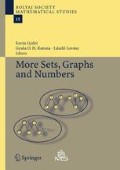Abstract
According to Euler’s formula, every planar graph with n vertices has at most O(n) edges. How much can we relax the condition of planarity without violating the conclusion? After surveying some classical and recent results of this kind, we prove that every graph of n vertices, which can be drawn in the plane without three pairwise crossing edges, has at most O(n) edges. For straight-line drawings, this statement has been established by Agarwal et al., using a more complicated argument, but for the general case previously no bound better than O(n 3/2) was known.
János Pach has been supported by NSF Grant CCR-00-98245, by PSC-CUNY Research Award 63352-0036, and by OTKA T-032458. Géza Tóth has been supported by OTKA-T-038397 and by an award from the New York University Research Challenge Fund.
Access this chapter
Tax calculation will be finalised at checkout
Purchases are for personal use only
Preview
Unable to display preview. Download preview PDF.
References
P. K. Agarwal, B. Aronov, J. Pach, R. Pollack and M. Sharir, Quasi-planar graphs have a linear number of edges, Combinatorica, 17 (1997), 1–9.
M. Ajtai, V. Chvátal, M. Newborn and E. Szemerédi, Crossing-free subgraphs, in: Theory and Practice of Combinatorics, North-Holland Math. Stud., 60, North-Holland, Amsterdam-New York, 1982, 9–12.
N. Alon and P. Erdős, Disjoint edges in geometric graphs, Discrete Comput. Geom., 4 (1989), 287–290.
Bollobás and A. Thomason, Proof of a conjecture of Mader, Erdős and Hajnal on topological complete subgraphs, European J. Combin., 19 (1998), 883–887.
P. Braß, G. Károlyi and P. Valtr, A Turán-type extremal theory for convex geometric graphs, in: Discrete and Computational Geometry — The Goodman-Pollack Festschrift (B. Aronov et al., eds.), Springer Verlag, Berlin, 2003, to appear.
G. Cairns and Y. Nikolayevsky, Bounds for generalized thrackles, Discrete Comput. Geom., 23 (2000), 191–206.
V. Capoyleas and J. Pach, A Turán-type theorem on chords of a convex polygon, Journal of Combinatorial Theory, Series B, 56 (1992), 9–15.
W. Goddard, M. Katchalski and D. J. Kleitman, Forcing disjoint segments in the plane, European J. Combin., 17 (1996), 391–395.
H. Hopf and E. Pannwitz, Aufgabe Nr. 167, Jahresbericht der deutschen Mathematiker-Vereinigung, 43 (1934), 114.
J. Komlós and E. Szemerédi, Topological cliques in graphs II, Combin. Probab. Comput., 5 (1996), 79–90.
A. V. Kostochka, Lower bound of the Hadwiger number of graphs by their average degree, Combinatorica, 4 (1984), 307–316.
A. V. Kostochka, Upper bounds on the chromatic number of graphs (in Russian), Trudy Inst. Mat. (Novosibirsk), Modeli i Metody Optim., 10 (1988), 204–226.
A. V. Kostochka and J. Kratochvíl, Covering and coloring polygon-circle graphs, Discrete Math., 163 (1997), 299–305.
F. T. Leighton, New lower bound techniques for VLSI, Math. Systems Theory, 17 (1984), 47–70.
L. Lovász, J. Pach and M. Szegedy, On Conway’s thrackle conjecture, Discrete and Computational Geometry, 18 (1997), 369–376.
W. Mader, 3n — 5 edges do force a subdivision of K 5, Combinatorica, 18 (1998), 569–595.
P. Kolman and J. Matoušek, Crossing number, pair-crossing number, and expansion, J. Comb. Theory, Ser. B, 92 (2004), 99–113.
S. McGuinness, Colouring arcwise connected sets in the plane I, Graphs & Combin., 16 (2000), 429–439.
J. Pach, Geometric graph theory, in: Surveys in Combinatorics, 1999 (J. D. Lamb and D. A. Preece, eds.), London Mathematical Society Lecture Notes, 267, Cambridge University Press, Cambridge, 1999, 167–200.
J. Pach, R. Pinchasi, M. Sharir and G. Tóth, Topological graphs with no large grids, Special Issue dedicated to Victor Neumann-Lara, Graphs and Combinatorics (accepted).
J. Pach, R. Pinchasi, G. Tardos and G. Tóth, Geometric graphs with no self-intersecting path of length three, in: Graph Drawing (M. T. Goodrich, S. G. Kobourov, eds.), Lecture Notes in Computer Science 2528, Springer-Verlag (Berlin, 2002), 295–311. Also in: European Journal of Combinatorics, 25 (2004), 793–811.
J. Pach, R. Radoičić and G. Tóth, A generalization of quasi-planarity, in: Towards a Theory of Geometric Graphs (J. Pach, ed.), Contemporary Mathematics 342, AMS (2004), 177–183.
J. Pach, R. Radoičić, G. Tardos and G. Tóth, Improving the Crossing Lemma by finding more crossings in sparse graphs, Proceedings of the 20th Annual Symposium on Computational Geometry (2004), 68–75. Also in: Discrete and Computational Geometry, accepted.
J. Pach, F. Shahrokhi and M. Szegedy, Applications of the crossing number, Algorithmica, 16 (1996), 111–117.
J. Pach and G. Tóth, Graphs drawn with few crossings per edge, Combinatorica, 17 (1997), 427–439.
J. Pach and J. Törőcsik, Some geometric applications of Dilworth’s theorem, Discrete Comput. Geom., 12 (1994), 1–7.
R. Pinchasi and R. Radoičić, Topological graphs with no self-intersecting cycle of length 4, Proceedings of the 19th Annual Symposium on Computational Geometry (2003), 98–103. Also in: Towards a Theory of Geometric Graphs (J. Pach, ed.), Contemporary Mathematics 342, AMS (2004), 233–243.
N. Robertson, P. Seymour and R. Thomas, Hadwiger’s conjecture for K 6-free graphs, Combinatorica, 13 (1993), 279–361.
O. Sýkora and I. Vrt’o, On VLSI layouts of the star graph and related networks, Integration, The VLSI Journal, 17 (1994), 83–93.
G. Tardos, Construction of locally plane graphs, manuscript.
A. Thomason, An extremal function for contractions of graphs, Math. Proc. Cambridge Philos. Soc., 95 (1984), 261–265.
G. Tóth, Note on geometric graphs, J. Combin. Theory, Ser. A, 89 (2000), 126–132.
A. Thomason, The extremal function for complete minors, J. Combin. Theory Ser. B, 81 (2001), 318–338.
P. Valtr, On geometric graphs with no k pairwise parallel edges, Discrete and Computational Geometry, 19 (1998), 461–469.
D. R. Woodall, Thrackles and deadlock, in: Combinatorial Mathematics and its Applications (Proc. Conf., Oxford, 1969), Academic Press, London, 1971, 335–347.
Author information
Authors and Affiliations
Editor information
Editors and Affiliations
Rights and permissions
Copyright information
© 2006 János Bolyai Mathematical Society and Springer Verlag
About this chapter
Cite this chapter
Pach, J., Radoičić, R., Tóth, G. (2006). Relaxing Planarity for Topological Graphs. In: Győri, E., Katona, G.O.H., Lovász, L., Fleiner, T. (eds) More Sets, Graphs and Numbers. Bolyai Society Mathematical Studies, vol 15. Springer, Berlin, Heidelberg. https://doi.org/10.1007/978-3-540-32439-3_12
Download citation
DOI: https://doi.org/10.1007/978-3-540-32439-3_12
Publisher Name: Springer, Berlin, Heidelberg
Print ISBN: 978-3-540-32377-8
Online ISBN: 978-3-540-32439-3
eBook Packages: Mathematics and StatisticsMathematics and Statistics (R0)

